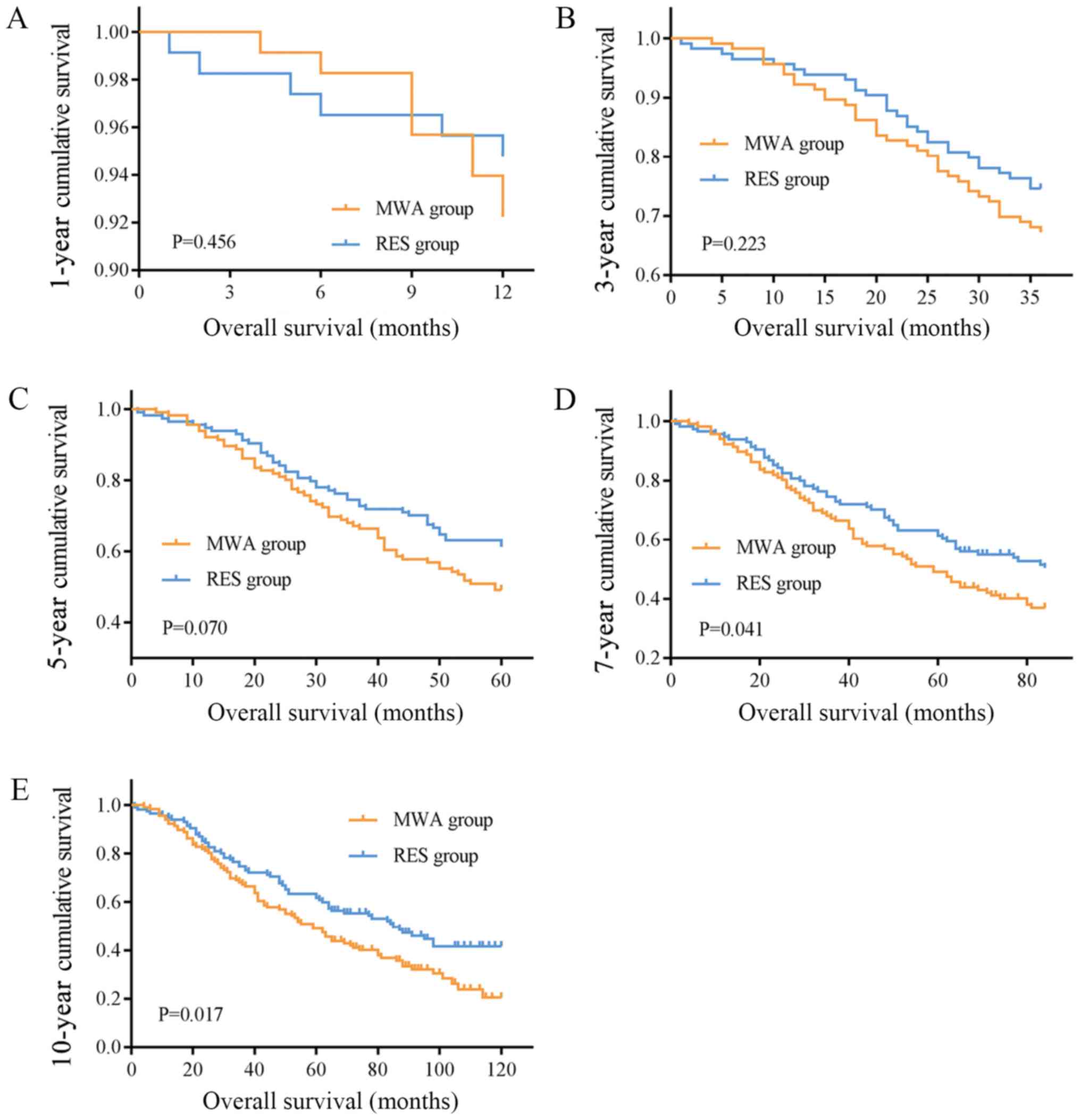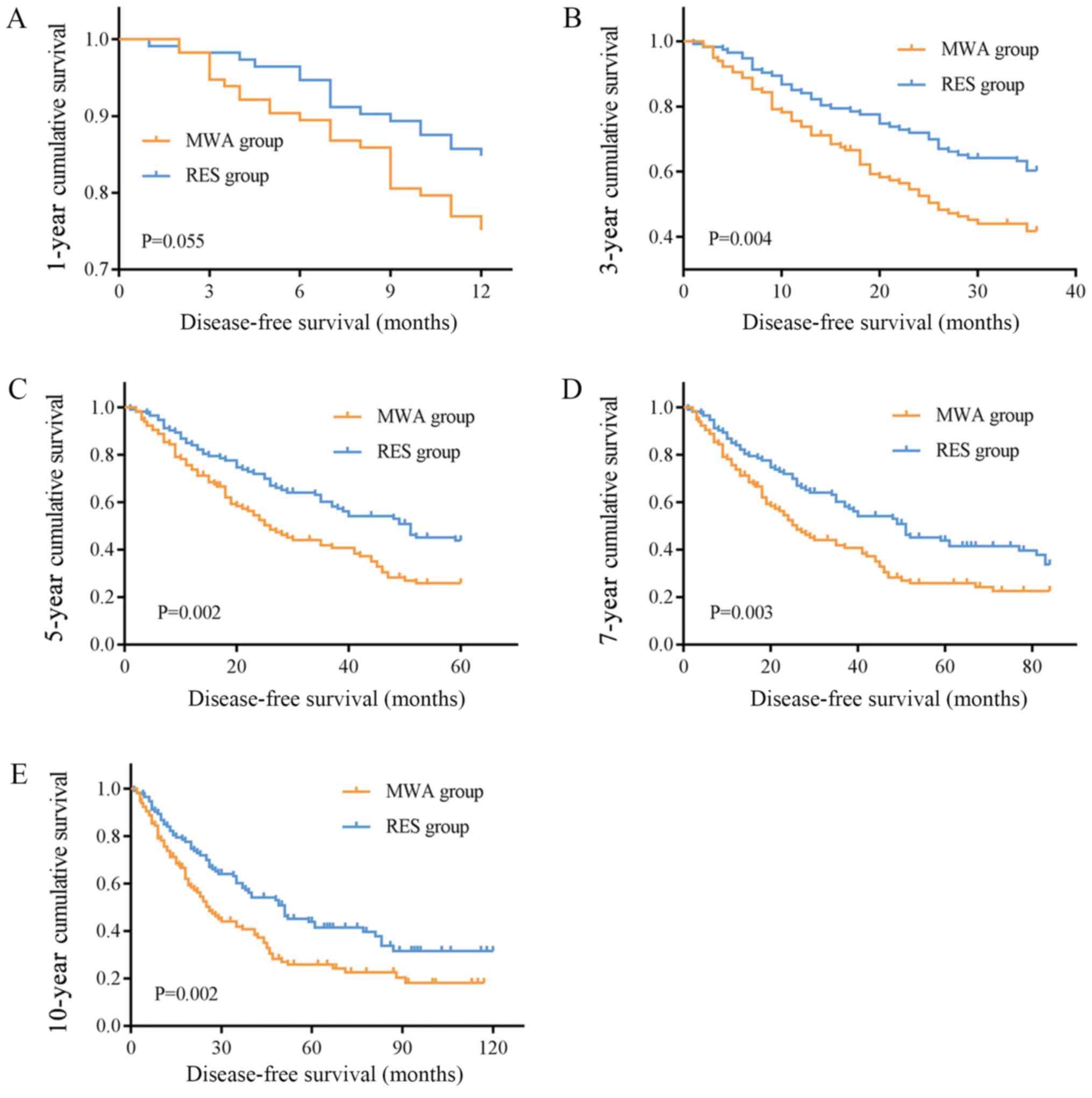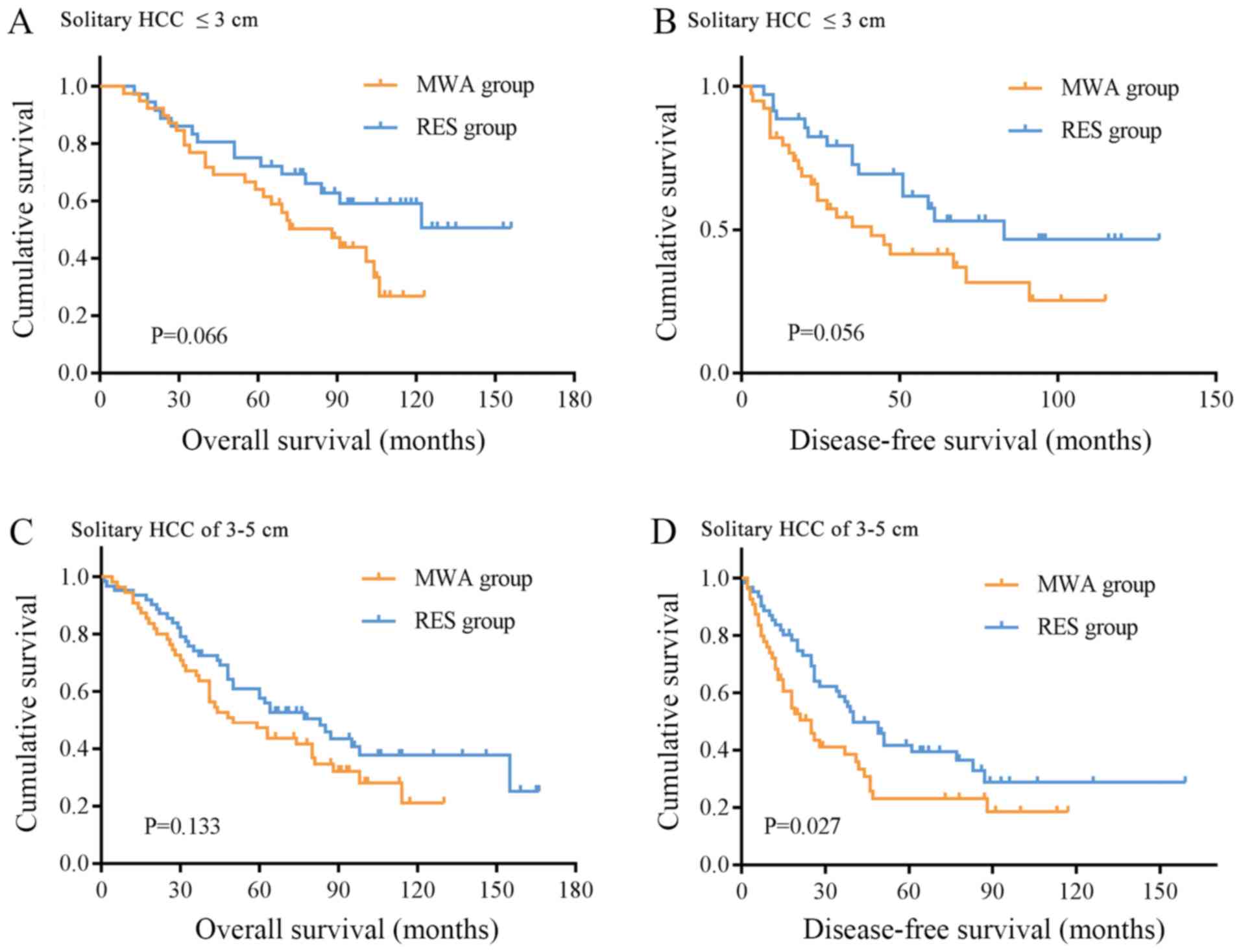|
1
|
Cross TJS and Evans JC: Transarterial
embolization therapies in hepatocellular carcinoma: Principles of
management: From mechanisms to management. Liver Cancers. Springer
International Publishing Corp.; Berlin: pp. 123–138. 2019,
View Article : Google Scholar
|
|
2
|
Valery PC, Laversanne M, Clark PJ, Petrick
JL, McGlynn KA and Bray F: Projections of primary liver cancer to
2030 in 30 countries worldwide. Hepatology. 2:600–611. 2018.
View Article : Google Scholar
|
|
3
|
Cong WM, Bu H and Chen J, Dong H, Zhu YY,
Feng LH and Chen J; Guideline Committee, : Practice guidelines for
the pathological diagnosis of primary liver cancer: 2015 update.
World J Gastroenterol. 22:9279–9287. 2016. View Article : Google Scholar : PubMed/NCBI
|
|
4
|
Torre LA, Bray F, Siegel RL, Ferlay J,
Lortet-Tieulent J and Jemal A: Global cancer statistics, 2012. CA
Cancer J Clin. 65:87–108. 2015. View Article : Google Scholar : PubMed/NCBI
|
|
5
|
Chen WQ, Zheng RS and Zhang SW: Liver
cancer incidence and mortality in China, 2009. Chin J Cancer.
32:162–169. 2013. View Article : Google Scholar : PubMed/NCBI
|
|
6
|
Bureau of Medical Administration National
Health and Family Planning Comission of the People's Republic of
China, . Diagnosis, management, and treatment of hepatocellular
carcinoma (V2017). Zhonghua Gan Zang Bing Za Zhi. 25:886–895.
2017.(In Chinese). PubMed/NCBI
|
|
7
|
Duffy AG, Ulahannan SV, Makorova-Rusher O,
Rahma O, Wedemeyer H, Pratt D, Davis JL, Hughes MS, Heller T,
ElGindi M, et al: Tremelimumab in combination with ablation in
patients with advanced hepatocellular carcinoma. J Hepatol.
66:545–551. 2017. View Article : Google Scholar : PubMed/NCBI
|
|
8
|
Klein S and Dufour JF: Nonalcoholic fatty
liver disease and hepatocellular carcinoma. Hepat Oncol. 4:83–98.
2017. View Article : Google Scholar : PubMed/NCBI
|
|
9
|
Boyer TD and Haskal ZJ; American
Association for the Study of Liver Diseases, : The role of
transjugular intrahepatic portosystemic shunt (TIPS) in the
management of portal hypertension: Update 2009. Hepatology.
51:3062010. View Article : Google Scholar : PubMed/NCBI
|
|
10
|
European Association for the Study of the
Liver. Electronic address, . simpleeasloffice@easloffice.eu;
European Association for the Study of the Liver: EASL clinical
practice guidelines: Management of hepatocellular carcinoma. J
Hepatol. 69:182–236. 2018. View Article : Google Scholar : PubMed/NCBI
|
|
11
|
Fukuda H: European organization for
research and treatment of cancer. Jpn J Clin Oncol.
30:1692000.PubMed/NCBI
|
|
12
|
Zhou Y, Xu X, Ding J, Jing X, Wang F, Wang
Y and Wang P: Dynamic changes of T-cell subsets and their relation
with tumor recurrence after microwave ablation in patients with
hepatocellular carcinoma. J Cancer Res Ther. 14:40–45. 2018.
View Article : Google Scholar : PubMed/NCBI
|
|
13
|
Peng ZW, Lin XJ, Zhang YJ, Liang HH, Guo
RP, Shi M and Chen MS: Radiofrequency ablation versus hepatic
resection for the treatment of hepatocellular carcinomas 2 cm or
smaller: A retrospective comparative study. Radiology.
262:1022–1033. 2012. View Article : Google Scholar : PubMed/NCBI
|
|
14
|
Shi J, Sun Q, Wang Y, Jing X, Ding J, Yuan
Q, Ren C, Shan S, Wang Y and Du Z: Comparison of microwave ablation
and surgical resection for treatment of hepatocellular carcinomas
conforming to Milan criteria. J Gastroenterol Hepatol.
29:1500–1507. 2014. View Article : Google Scholar : PubMed/NCBI
|
|
15
|
Lencioni R and Llovet JM: Modified RECIST
(mRECIST) assessment for hepatocellular carcinoma. Semin Liver Dis.
1:52–60. 2010. View Article : Google Scholar
|
|
16
|
Goldberg SN, Grassi CJ, Cardella JF,
Charboneau JW, Dodd GD III, Dupuy DE, Gervais D, Gillams AR, Kane
RA, Lee FT Jr, et al: Image-guided tumor ablation: Standardization
of terminology and reporting criteria. Radiology. 235:728–739.
2005. View Article : Google Scholar : PubMed/NCBI
|
|
17
|
Llovet JM and Hernandez-Gea V:
Hepatocellular carcinoma: Reasons for phase III failure and novel
perspectives on trial design. Clin Cancer Res. 20:2072–2079. 2014.
View Article : Google Scholar : PubMed/NCBI
|
|
18
|
Li X, Li B, Li B, Guo T, Sun Z, Li X, Chen
L, Chen W, Chen P, Mao Y and Zeng Y: ITIH4: Effective serum marker,
early warning and diagnosis, hepatocellular carcinoma. Pathol Oncol
Res. 24:663–670. 2018. View Article : Google Scholar : PubMed/NCBI
|
|
19
|
Bréchot C: Pathogenesis of hepatitis B
virus-related hepatocellular carcinoma: Old and new paradigms.
Gastroenterology. 127 (5 Suppl 1):S56–S61. 2004. View Article : Google Scholar : PubMed/NCBI
|
|
20
|
El-Serag HB: Epidemiology of viral
hepatitis and hepatocellular carcinoma. Gastroenterology.
142:1264–1273.e1. 2012. View Article : Google Scholar : PubMed/NCBI
|
|
21
|
Chen MS, Li JQ, Zheng Y, Guo RP, Liang HH,
Zhang YQ, Lin XJ and Lan WY: A prospective randomized trial
comparing percutaneous local ablative therapy and partial
hepatectomy for small hepatocellular carcinoma. Ann Surg.
243:321–328. 2006. View Article : Google Scholar : PubMed/NCBI
|
|
22
|
Feng K, Yan J, Li X, Xia F, Ma K, Wang S,
Bie P and Dong J: A randomized controlled trial of radiofrequency
ablation and surgical resection in the treatment of small
hepatocellular carcinoma. J Hepatol. 57:794–802. 2012. View Article : Google Scholar : PubMed/NCBI
|
|
23
|
Thandassery RB, Goenka U and Goenka MK:
Role of local ablative therapy for hepatocellular carcinoma. J Clin
Exp Hepatol. 4 (Suppl 3):S104–S111. 2014. View Article : Google Scholar : PubMed/NCBI
|
|
24
|
Yan X, Fu BM, Tang B, et al: Progress in
clinical research of radiofrequency ablation for primary liver
cancer. J Hepato Surg. 1:87–89. 2016.
|
|
25
|
Lau WY and Lai EC: The current role of
radiofrequency ablation in the management of hepatocellular
carcinoma: A systematic review. Ann Surg. 249:20–25. 2009.
View Article : Google Scholar : PubMed/NCBI
|
|
26
|
Poggi G, Tosoratti N, Montagna B and
Picchi C: Microwave ablation of hepatocellular carcinoma. World J
Hepatol. 7:2578–2589. 2015. View Article : Google Scholar : PubMed/NCBI
|
|
27
|
Wright AS, Sampson LA, Warner TF, Mahvi DM
and Lee FT Jr: Radiofrequency versus microwave ablation in a
hepatic porcine model. Radiology. 236:132–139. 2005. View Article : Google Scholar : PubMed/NCBI
|
|
28
|
Lucchina N, Tsetis D, Ierardi AM,
Giorlando F, Macchi E, Kehagias E, Duka E, Fontana F, Livraghi L
and Carrafiello G: Current role of microwave ablation in the
treatment of small hepatocellular carcinomas. Ann Gastroenterol.
29:460–465. 2016.PubMed/NCBI
|
|
29
|
Wang JH, Wang CC, Hung CH, Chen CL and Lu
SN: Survival comparison between surgical resection and
radiofrequency ablation for patients in BCLC very early/early stage
hepatocellular carcinoma. J Hepatol. 56:412–418. 2012. View Article : Google Scholar : PubMed/NCBI
|
|
30
|
Harada N, Shirabe K, Maeda T, Kayashima H,
Takaki S and Maehara Y: Comparison of the outcomes of patients with
hepatocellular carcinoma and portal hypertension after liver
resection versus radiofrequency ablation. World J Surg.
40:1709–1719. 2016. View Article : Google Scholar : PubMed/NCBI
|
|
31
|
Kim SJ, Lee KK and Kim DG: Tumor size
predicts the biological behavior and influence of operative
modalities in hepatocellular carcinoma. Hepatogastroenterology.
57:121–126. 2010.PubMed/NCBI
|
|
32
|
Chen X, Zhang B, Yin X, Ren Z, Qiu S and
Zhou J: Lipiodolized transarterial chemoembolization in
hepatocellular carcinoma patients after curative resection. J
Cancer Res Clin Oncol. 139:773–781. 2013. View Article : Google Scholar : PubMed/NCBI
|
|
33
|
Lazzara C, Navarra G, Lazzara S, Barbera
A, Saitta C, Raimondo G, Latteri S and Curro G: Does the margin
width influence recurrence rate in liver surgery for hepatocellular
carcinoma smaller than 5 cm? Eur Rev Med Pharmacol Sci. 21:523–529.
2017.PubMed/NCBI
|
|
34
|
Qian GJ, Wang N, Shen Q, Sheng YH, Zhao
JQ, Kuang M, Liu GJ and Wu MC: Efficacy of microwave versus
radiofrequency ablation for treatment of small hepatocellular
carcinoma: Experimental and clinical studies. Eur Radiol.
22:1983–1990. 2012. View Article : Google Scholar : PubMed/NCBI
|
|
35
|
Huo TI, Liu WY, Wu JC, Huang YH, King KL,
Loong CC, Lee PC, Chang FY and Lee SD: Deterioration of hepatic
functional reserve in patient with hepatocellular carcinoma after
resection: Incidence risk factors, and association with
intrahepatic tumor recurrence. World J Surg. 28:258–262. 2004.
View Article : Google Scholar : PubMed/NCBI
|
|
36
|
Yang W: Current status and prospective of
imaging guided radiofrequency ablation in medium to large sized
hepatocellular carcinomas. World Chin J Digestol. 30:47712015.(In
Chinese). View Article : Google Scholar
|
|
37
|
Pompili M, Saviano A, de Matthaeis N,
Cucchetti A, Ardito F, Federico B, Brunello F, Pinna AD, Giorgio A,
Giulini SM, et al: Long-term effectiveness of resection and
radiofrequency ablation for single hepatocellular carcinoma ≤3 cm.
Results of a multicenter Italian survey. J Hepatol. 59:89–97. 2013.
View Article : Google Scholar : PubMed/NCBI
|
|
38
|
Zhang P, Gu A and Shi DM: Analysis of the
status of postoperative recurrence and metastasis of hepatocellular
carcinoma and its influencing factors. Oncol Prog. 4:2017.
|
|
39
|
Li T, Wang SK, Zhou J, Sun HC, Qiu SJ, Ye
QH, Wang L and Fan J: Positive HBcAb is associated with higher risk
of early recurrence and poorer survival after curative resection of
HBV-related HCC. Liver Int. 36:284–292. 2016. View Article : Google Scholar : PubMed/NCBI
|
|
40
|
Huang JQ, Peng MH, Zou YQ, Yang DH, Chen B
and Xiao KY: Analysis of risk factors for early recurrence of
primary hepatocellular carcinoma after radical hepatectomy. Chinese
J Practl Surg. 5:418–420. 2009.(In Chinese).
|


















